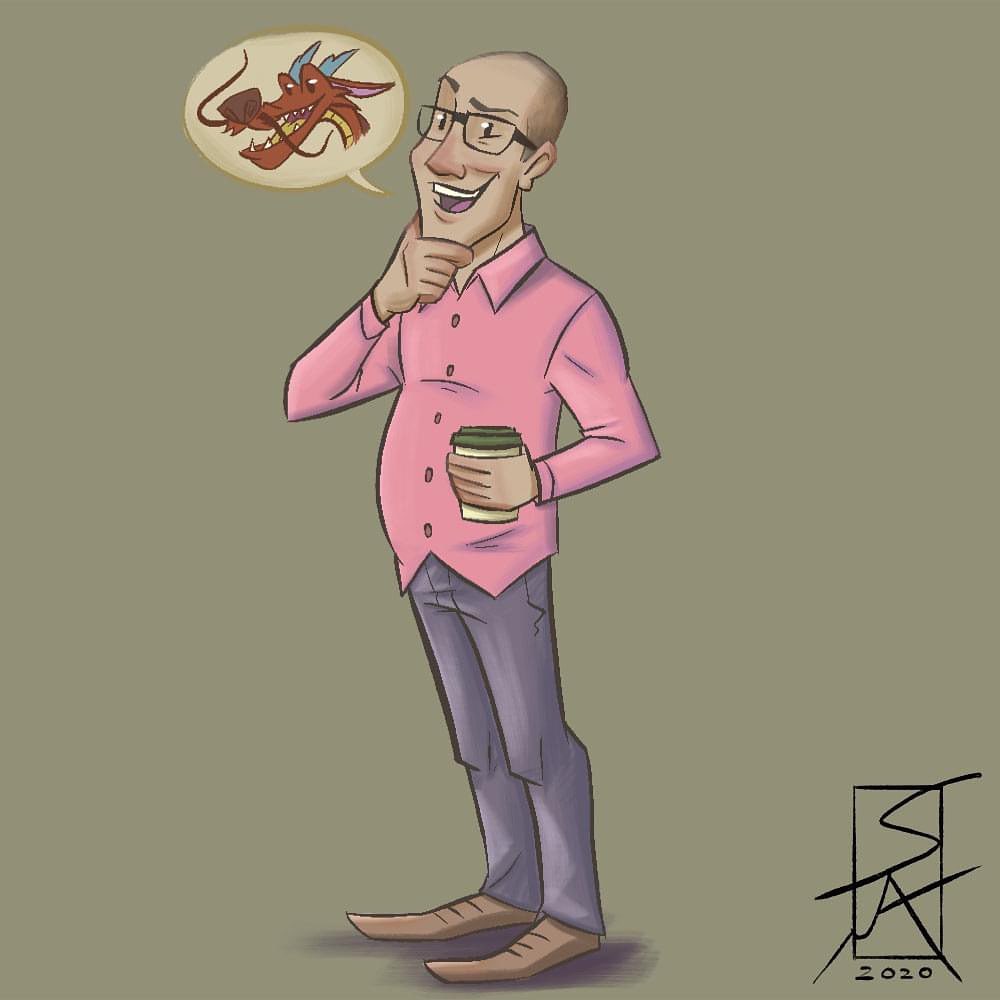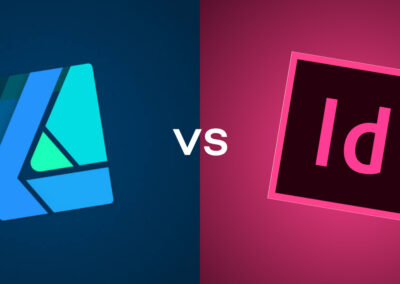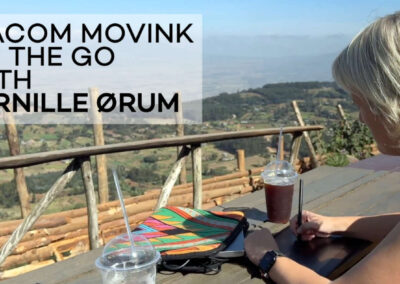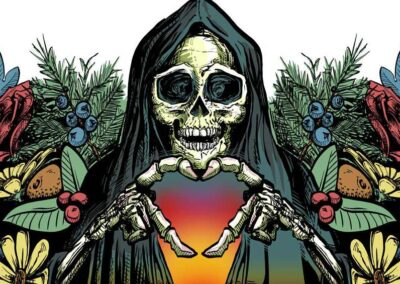Header image from Lipscomb University
Tom Bancroft is the creator of MerMay and the head judge of our end-of-the-month contest. Many of our contributors this year have worked for Disney, but he’s the one who’s done it most extensively, working in some capacity on most of their movies of the ‘90s. Notable accomplishments include designing Eddie Murphy’s goofy dragon Mushu for 1998’s Mulan—as his social media bios proudly proclaim—and animating scenes for Simba in The Lion King, Iago and Jafar in Aladdin, and Pocahontas in… yeah.
Today, he writes books on character design, illustrates children’s books and comics, teaches both at Nashville’s Lipscomb University and online, and co-hosts the Bancroft Brothers Animation Podcast with his twin brother, Tony, who has a similar resume. His own project this year is a webcomic called Riding the Wave, about a mermaid who comes ashore to become a pop singer. …And pursue her caffeine addiction.

In addition, he’s also preparing to host a four-day “Character Drawing Boot Camp” via Zoom in June, for which, as I found out, slots are still open.
I spoke to him via email.
On Character Design
First off, do you think there’s a single most important aspect of character design? Charm? Uniqueness?
That’s a hard one. I would back it up even further, though, to shape. Establishing an iconic shape for the character is the heart of making them unique and recognizable.

Are there still spots open for the Zoom class? And can you give us a teaser of the kind of things we’ll learn if we take it?
Yes there are. Because it’s online, we can take registrations all the way up until the class starts in June. It’s a foundational class. I’ve been wanting to do something that was a little less intermediate-level because I’ve gotten more and more frustrated with how we don’t teach art to high school students anymore. This will be general character-drawing instruction, but also character design fundamentals. It’s a series of short classes over four days, and students will design a variety of characters including a mermaid, a superhero, and an animal character. It’s aimed toward high-school to adult artists and I’m doing it through Lipscomb University where I teach.
On Disney
Have you met any of the Nine Old Men? If so, what was that like?
Yes! I started at Disney in 1989 when about five of the Nine Old Men were still alive. I met them all at various times, and was even able to introduce Ward Kimball at a lecture he gave at the studio: It was a high point of my career. Everything we did was to try and get them to notice us. I asked Marc Davis once what he thought of Aladdin, which had just come out at the time, and he said, “It was pretty good. We wouldn’t have done it like that though. It wasn’t timeless. Too Trendy.” He wasn’t entirely wrong. 🙂
Did having daughters during your time with Disney affect the path you took in your art career from then on? And what was it like knowing the movies you were working on would be very influential in their childhoods?
While my four daughters—ages 18-26 now—all grew up around Disney films, they were never huge fans. They were mostly into other things. That said, they have an affinity for them, especially the ones I was working on when they were young. They look at them as “their” films because I was working on them and talking about them before they came out. They have a personal connection other kids didn’t have.
I read a bit of trivia that while making the Lion King, Disney brought real lions into the studio for the animators to use as reference. Did you get to see them?
I don’t want to risk embedding it because it belongs to Disney, but here’s a picture of that.
Yes, I did. Famous animal expert Jim Fowler brought in some buzzards, parrots, monkeys, lion cubs, and even a full grown lion for us to draw. It was intimate and amazing to be in a room with some of those animals. The grown lion was just lying on the stage and we could one by one come up, touch it, and pet its hindquarters while someone held onto the muzzle leash. It was eye-opening to feel the muscle in the hindquarters alone! I’ll never forget the power I felt that even a relaxed lion had—we tried our best to put some of that into the film.
On MerMay
What was the inspiration for Mermay? And what was the first year?
MerMay began in 2016 when I did a drawing of two teen mermaids lounging around on some sea rocks, mesmerized by their “shellphones.”
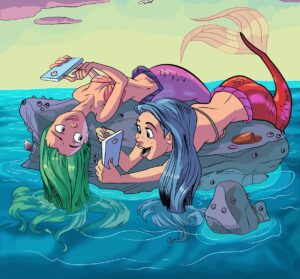
It went semi-viral and I decided to do a month of drawing mermaids and call it “MerMay,” because May was coming up. I invited my followers on Instagram to join me and it took off right away. I never pictured it still being around five years later and hundreds of thousands of artists taking part in it every year.
How does one go about creating something as widespread as a viral art hashtag and getting so many people to participate in it?
I have no idea. I wasn’t the first to create a monthly drawing challenge (Inktober by Jake Parker had been around for a few years) but something about mermaids tapped into a nostalgia point for many people. I think it comes from The Little Mermaid being such a popular film when many current artists were young. I had a large following too, mostly of artists in training—so as it turns out, this 50-year-old bald man was somehow the perfect fit for creating MerMay.
What has it been like trying to transition your Gallery Nucleus show online? Do you think you’ll be able to postpone the physical show for later in the year, or will you just try again next year?
No, we’re going for it online. No delays. It launched last week and will continue to the end of May, all online at GalleryNucleus.com. It’s gotten a great response, with many original art pieces selling on the first day, and many pre-orders for the Art of MerMay 2020 book, as well as limited-edition prints and pins by some of the best MerMay artists in the world! But I do look forward to doing it again next year face-to-face.

Concepts 1 and 2 for Drama on Mermaid Island—Gallery Nucleus
And Finally…
You primarily work with Cintiqs, but have you gotten to try the Wacom One? If so, what are your impressions of it?
Yes! It’s become my biggest recommendation to upcoming students, and we purchased 6 of them as “loaners” to my present students when our school needed to go remote for COVID-19 concerns. It really is a great product for a great price.

A good overview of Tom Bancroft’s work can be found on his website. His Instagram, a good overview of his MerMay work, is @tombancroft1. The Bancroft Brothers Animation Podcast is hosted on his educational network Taught By a Pro. If you’re interested in the full scope of his work in the animation industry, check out his IMDB page.
Responses edited, with permission, for clarity and concision.
About the Interviewer
![]() CS Jones is a Philadelphia-based writer and illustrator. The former is best seen at thecsjones.com, and the latter at @thecsjones on Instagram.
CS Jones is a Philadelphia-based writer and illustrator. The former is best seen at thecsjones.com, and the latter at @thecsjones on Instagram.

